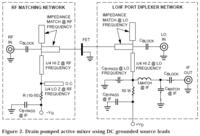muheeb16
Member level 3
I am designing a single ended FET mixer using atf21170 and I have isolated the RF and LO port by a bandpass filter,at the output I am using a 6th order chebyshev low pass filter.The major problem that I am facing is that of designing the matching section at the input.I don't know how to begin with that.Will someone please help me here?I do not want to use any other device model because I am almost done with this project.Just the mystery of matching section remains to be solved.I have the S-parameters available at my desired frequencies.


